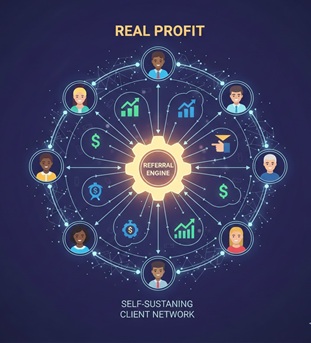For any business owner, the dream isn’t just a full client roster—it’s a roster that fills itself. Imagine a sales engine that doesn’t rely on endless, costly cold-calling, expensive ads, or desperate outreach. This is the promise of a Self-Sustaining Client Network (SSCN).
An SSCN is an operational ecosystem where happy clients not only return for repeat business but also actively and automatically refer new, high-quality customers. This shifts your business model from a high-churn, high-effort scramble to a stable, predictable, and profitable machine. By drastically reducing your Customer Acquisition Cost (CAC) and boosting your Customer Lifetime Value (CLTV), you move beyond merely making revenue to realizing a Real Profit.
Here is the step-by-step framework to build this powerful, self-fueling system.
The Foundation: Building a ‘Referral-Worthy’ Business
The biggest mistake is launching a referral program before your service is genuinely worth referring. A self-sustaining network must be built on a foundation of exceptional and consistent delivery.
1. Master the Experience, Not Just the Service
Delivering the promised product or service on time is the minimum requirement. What makes you referral-worthy is the experience surrounding that delivery.
- Consistency is Key: Every touchpoint—from the first sales call to the final invoice—must be professional, clear, and consistent. Inconsistent quality or communication erodes the trust that fuels referrals.
- Onboarding Excellence: The client’s first 90 days are critical for client retention. Set clear, realistic expectations, define success metrics together, and over-communicate progress. A smooth start drastically increases the chance of a long-term relationship.
- Value Visualization: Clients often forget the effort and value you deliver. Implement systems to regularly report on and visualize the impact you’ve had. This could be a monthly dashboard, a quarterly ‘Success Review’ document, or a simple email highlighting a key win. This preemptively justifies your value and prepares the client for the referral ask.
Building the Engine: Your Automated Referral System
Once your experience is exceptional, the next step is to systematize the ask. An ad-hoc “Can you recommend someone?” approach is not self-sustaining. You need a structured, rewarding system.
2. Design a Double-Sided Incentive Structure
The most effective Automated Referral Systems reward two parties: the referrer (your existing client) and the referred customer (the new client). This creates a powerful, immediate incentive for everyone involved.
| Incentive Type | Purpose | Example |
| For the Referrer | To motivate them to share. | A Service Credit (e.g., $500 off their next invoice), a high-value gift, or an exclusive service upgrade. (Non-cash incentives often feel more professional and valuable.) |
| For the Referred | To remove friction and encourage them to sign up. | A free high-value consultation, a waived onboarding fee, or an exclusive discount. |
The Power of Timing: The absolute best time to ask for a referral is the “Moment of Victory.” This is immediately after a major win, like a successful product launch, a huge quarterly result, or when they just sent a glowing testimonial. Their positive feelings are maximized, making the referral a natural extension of their gratitude.
3. Track and Automate the Process
Manual tracking is where most referral programs fail. To make it self-sustaining, integrate the process into your workflow:
- CRM Integration: Ensure your Customer Relationship Management (CRM) tool has a mandatory field: “How did you hear about us?” and a “Referred By” field.
- Unique Links/Codes: Give your top referrers a unique link or code. This simplifies tracking and ensures they get credit and their reward automatically when the new client signs the contract.
- Reward Fulfillment: Immediately fulfill the reward upon the new client’s payment. A prompt, genuine thank-you and reward reinforces the behavior and encourages future referrals.
Maximizing Real Profit through Retention and Expansion
A Self-Sustaining Client Network isn’t just about new clients; it’s about the continued profitability of your existing ones. It is five to twenty-five times more expensive to acquire a new client than to retain an existing one.
4. Optimize for Customer Lifetime Value (CLTV)
Your Real Profit comes from increasing the value of each client relationship. Focus on transforming single projects into long-term partnerships.
- Develop Retainer-Based Services: Design light-touch, high-value, recurring services (e.g., quarterly audits, ongoing strategy sessions, maintenance packages). These structures—Retainers and Bundled Packages—create predictable, recurring revenue, which is the cornerstone of a stable, profitable business.
- Systematize Upselling and Cross-Selling: Upselling shouldn’t feel pushy; it should feel like you’re serving them better. In your initial project proposal, include a phased roadmap (e.g., “Phase 1: Brand Strategy. Phase 2: Ongoing Social Content Management”). This plants the seed for future work from day one.
5. Cultivate Your Client Community
Turn your network from a list of transactions into a genuine community:
- Reciprocal Referrals: Be an active connector. Look for opportunities to refer your clients to your network. By giving first, you demonstrate partnership and increase the likelihood of them reciprocating.
- Exclusive Access: Treat your best clients like VIPs. Give them early access to new product features, host an exclusive annual event, or create a private online community. This sense of belonging further solidifies their loyalty and their desire to protect and grow your network.
By prioritizing an exceptional experience, automating the referral process, and focusing on long-term Client Retention, you stop chasing sales and start building an enduring business that generates Real Profit through a truly Self-Sustaining Client Network.
Who we are: Funded.com is a platform that is A+ BBB accredited over 10+ years. Access our network of Angel Investors, Venture Capital or Lenders. Let us professionally write your Business Plan.











